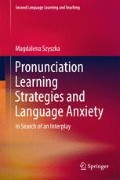Abstract
Second or foreign language (L2) learning or acquisition is a daunting process for most learners. Even if the external conditions are comparable, there are considerable differences in levels of achievement among language learners. One of the reasons for such a discrepancy is attributed to individual learner differences (ILD), which could either inhibit or accelerate learning. An instance of the limiting factor of an L2 learner’s potential is a high level of language anxiety (LA) experienced while learning a target language. However, there are many ILD that stimulate an L2 learning process, for example effective use of language learning strategies (LLS). Therefore, the extent to which a learner succeeds in L2 learning depends, among others, on the level of LA he or she experiences in the classroom and the language learning strategies he or she deploys while studying an L2.
Access this chapter
Tax calculation will be finalised at checkout
Purchases are for personal use only
Notes
- 1.
Although the author is aware of Krashen’s (1981) and Krashen and Terrell’s (1983) theoretical distinction between the terms ‘learning’ and ‘acquisition’ used in SLA resources, in this book these terms are used interchangeably.
- 2.
In this volume a foreign language (FL) is understood as one learnt mainly in the classrooms of a country where it is not an official language; whereas a second language (SL) is viewed as one acquired in an environment where this language plays an important administrative, cultural and social role (cf. Ellis, 2008, p. 6).
Author information
Authors and Affiliations
Corresponding author
Rights and permissions
Copyright information
© 2017 Springer International Publishing AG
About this chapter
Cite this chapter
Szyszka, M. (2017). Introduction. In: Pronunciation Learning Strategies and Language Anxiety. Second Language Learning and Teaching. Springer, Cham. https://doi.org/10.1007/978-3-319-50642-5_1
Download citation
DOI: https://doi.org/10.1007/978-3-319-50642-5_1
Published:
Publisher Name: Springer, Cham
Print ISBN: 978-3-319-50641-8
Online ISBN: 978-3-319-50642-5
eBook Packages: EducationEducation (R0)

